 Kinematics of Face-On Galaxies
Kinematics of Face-On Galaxies  Kinematics of Face-On Galaxies
Kinematics of Face-On Galaxies Collaborators: D. R. Andersen, L. Sparke, J. S. Gallagher, E. M. Wilcots
Face-on systems, as it turns out, are a wonderful laboratory for exploring the intrinsic shapes of disks. Projection effects in the photometric structure are minimized, as too is internal extinction. Historically, the problem with studying such systems has been the inability to determine their precise inclinations and hence true rotation speeds, or higher-order details of their kinematics.
Andersen, for his Ph.D. thesis, has studied a sample of roughly 40 nearby, nearly face-on late-type, luminous spirals. For these systems he has obtained echelle-resolution integral-field spectroscopy using DensePak on the WIYN 3.5m telescope, as well as obtaining B, R, I, J and K band images for these systems at WIYN, the KPNO 2.1m, and McDonald Observatory. With these data, we have been able to study the detailed photometric and kinematic properties of these systems, determine their intrinsic shapes, and establish a Tully-Fisher relation for these face-on systems.
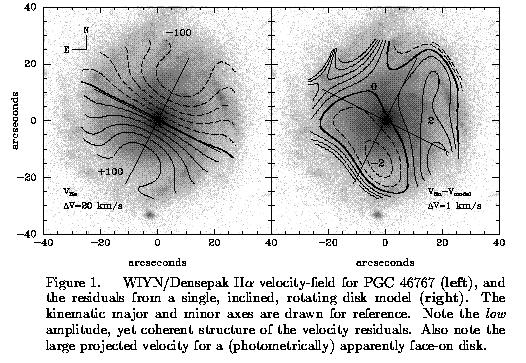
(b) Determining accurate inclincations for nearly face-on systems: The party-line in the kinematics game has been that inclinations cannot be detemined reliably from kinematics for galaxies with true inclinations under 40 degrees. We believe this was simply a historical artifact of poor data quality based on previous generations of HI surveys. We have found that the quality of our optical H-alpha echelle kinematic data is sufficiently high that we can accurately determine kinematic inclincation angles to 15-20 degrees (from Bershady & Andersen 1999). This opens the possibility of using such data to determine the intrinsic ellipticity of spiral disks, to study the Tully-Fisher relation in face-one galaxies, and to measure both rotation speed and vertical velocities of matter in disks.
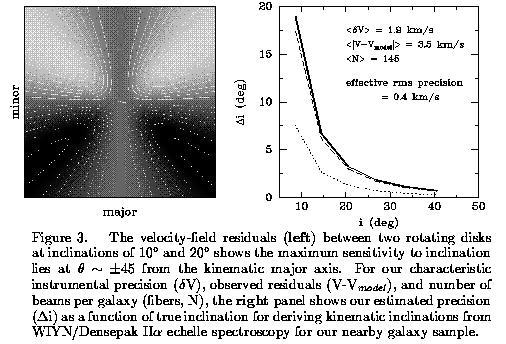
(c) The Shape of Galaxy Disks: By combinning photometric and kinematic maps of our nearly face-on systems, we are able to measure the intrincis ellipticity of the disks. This is done by comparing the mis-match between the kinematic and photometric position angles of the major axis, in combination with the observed apparent photometic ellipticity (photomeric axial ratio, b/a), and the true inclination as determined from the kinematics. The procedure is illustrated here:
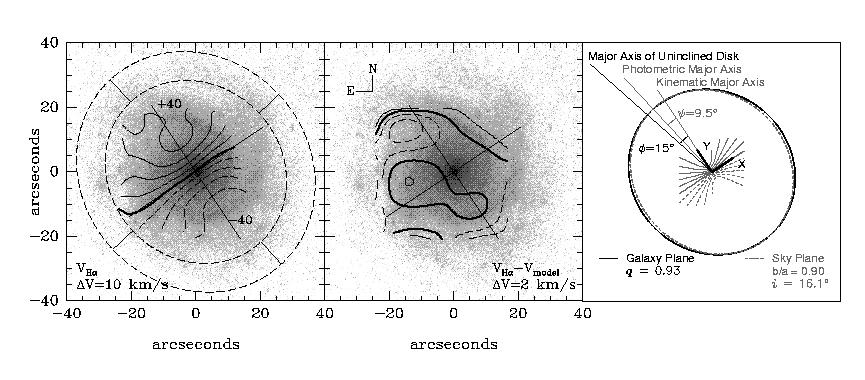
In the left panel is the H-alpha velocity field (contours) for UGC 4380, overlayed on a grey-scale image taken in the R band. The major and minor kinematic axes are labeled, based on a simple fit to the observed velocity field. The photometric major and minor axes are labeled within the dashed annulus, and exhibit an offset from the kinematic values. The central panel shows the residuals between our simple model velocity field and the observed data simply to show that these residuals are very small. The right panel shows how the mis-matched position angles are used to derive an intrinsic inclination.
With these data in hand, we find that the galaxy disks we have analyzed so far have intrinsic ellipticity at the 5-7% level (on average). This level is significant. At this time, the cause of the ellipticity is tantalizingly unknown. This will require further study!
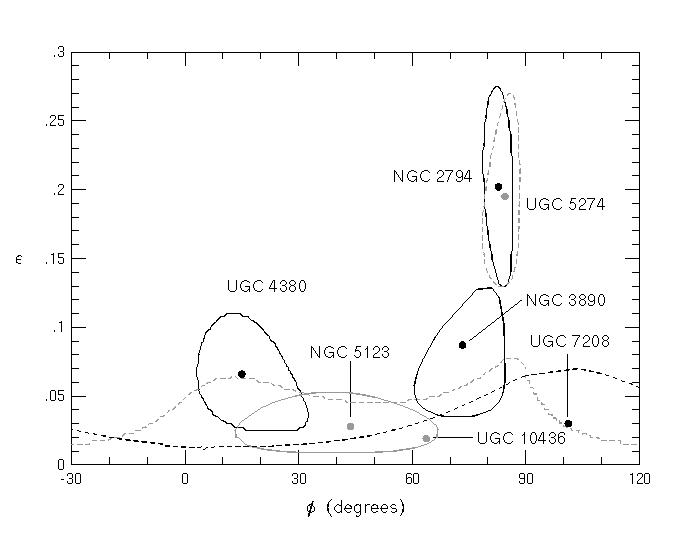
(c) The Scatter Budget in the Tully-Fisher Relation: Based on our measurement of the intrinsic ellipticity of spiral disks, we have determined that this ellipticity conributes up to 50% of the total scatter observed in this line-width--luminosity relation. As such, this indicates that there is only 0.1-0.2 mag left for all other sources of astrophysical scatter in the Tully-Fisher Relation. This places severe limits, for example, on the stellar and total M/L in these disk systems.
(d) A Face-On Tully-Fisher Relation: Another side-product of this survey is the first determination of the line-wdith--luminosity relation for face-on galaxies. This is significant for two reasons. First, internal extinction corrections are minimized overall, and the differential systematic errors in these corrections are essentially eliminated. Second, these systems are ideal for measuring the z-component of the stellar disk velocity dispersion. With this information plus the rotation speed in hand, plus an assumption about the relevant disk scale height, the mass distribution of the galaxy can be decomposed between disk and halo. This is the goal of our proposed programs with SparsePak.
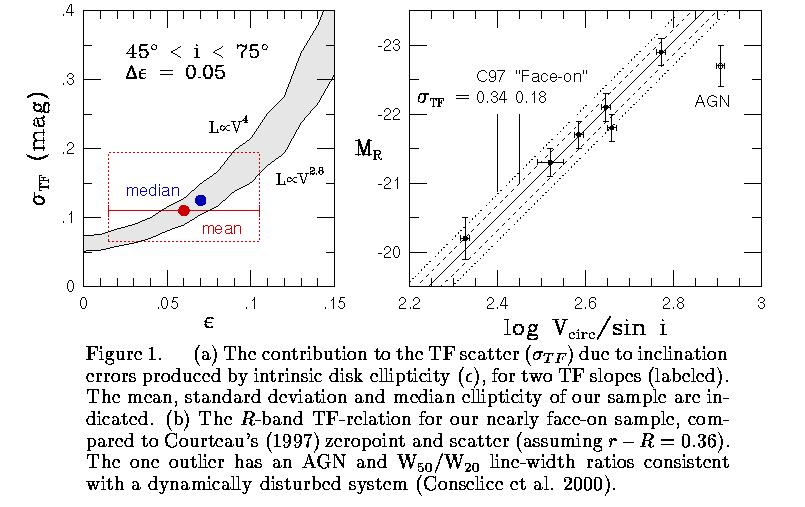
The Evolution of Spiral Disks, M. A. Bershady and D. R. Andersen 1999, to appear in "Dynamics of Galaxies: from the Early Universe to the Present," eds. F. Combes, G.A. Mamon & V. Charmandaris (San Francisco: ASP), 197, 175. (reprint: [astro-ph/9910281]) Funded under AST-9970780
Rotation Curves and M/L Evolution for Galaxies to z=0.4, Bershady, M. A., Haynes, M. P., Giovanelli, R., Andersen, D. R. 1999, in "Galaxy Dynamics," eds. D.R. Merritt, M. Valluri, J.A. Sellwood (ASP Conference Series), 182, 499 (reprint: [UW Preprint])
Galaxy Kinematics with Integral Field Spectroscopy, Andersen, D. R., Bershady, M. A. 1999, in "Galaxy Dynamics," eds. D.R. Merritt, M. Valluri, J.A. Sellwood (ASP Conference Series), 182, 215 (reprint: [UW Preprint]) Funded under AST-9618849
Galaxy Kinematics with Integral Field Spectroscopy and the Hobby-Eberly Telescope, Bershady, M. A., Andersen, D., Ramsey, L., Horner, S. 1998, Fiber Optics in Astronomy III, eds. S. Arribas, E. Mediavilla, F. Watson, (ASP Conference Series), 152, 253 (reprint: [high resolution]) Funded under AST-9618849
| |
|
|
|